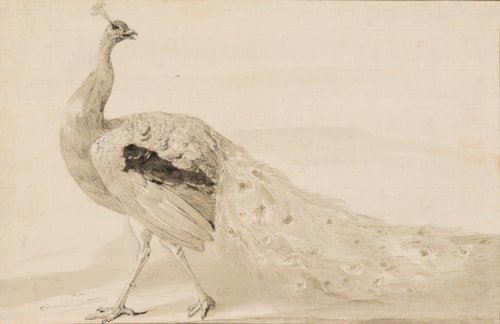
Melchior D'HONDECOETER
Utrecht 1636 - Amsterdam 1695
Biography
Born into an illustrious family of landscape and animal painters of Flemish origins that included his great-grandfather, grandfather, father, uncle and cousin, Melchior d’Hondecoeter became the leading Dutch painter of birds in the second half of the 17th century. His work was renowned for its lifelike and colourful depictions of avian subjects - both common and exotic types - painted with considerable accuracy. He received his artistic training from his father Gijsbert Gillisz. d’Hondecoeter and his uncle Jan Baptist Weenix in the 1650s, and became a member of the ‘Confrerie Pictura’, the artist’s association in Utrecht. By August 1658 he had moved to The Hague, joining the artist’s guild there in 1659. (His original presentation piece was a seascape, but he withdrew it in favour of an animal painting.) In 1662 Hondecoeter became the head of the ‘Confrerie Pictura’ in The Hague. By the beginning of the following year, however, the newly-married artist had settled in Amsterdam, where he was to live and work for the remainder of his career, and where he gained citizenship in 1668.
Hondecoeter came to specialize in highly realistic paintings of birds and fowl and, with his remarkable powers of observation and understanding of the behaviour of all manner of domestic and exotic birds, became indisputably the most renowned artist in this particular genre. He found a ready market for his accurate depictions of native European birds, as well as many unusual species from Asia, Africa and South America, all depicted in landscape settings. As the Hondecoeter scholar Joy Kearney has noted, ‘The most remarkable aspect of his work is the ornithological accuracy with which he depicted his subjects…Such realistic interpretation of birds was unrivalled in seventeenth-century art and paved the way for a new genre in Dutch art of the period.’
It is thought that Hondecoeter painted over 250 works, ranging from game pieces, barnyard scenes with poultry, and still life compositions, as well as the occasional portrait and a number of allegorical subjects, notably two large canvases of fighting birds known as The Lowland Wars of William III, today at Holkham Hall in Norfolk. Only about twenty of his paintings are dated, however, which makes a chronology of his work difficult to establish with any degree of certainty. Hondecoeter’s paintings are indebted to the example of the earlier Flemish artist Frans Snyders, some of whose works he owned, and, like Snyders, he sometimes based his compositions on Dutch proverbs or fables, creating a dramatic narrative. The artist also produced a number of grand park landscapes populated by exotic live birds, sometimes very large in scale. This was a particularly inventive genre that he created and developed, and which became especially popular in the form of decorations for town and country homes of such wealthy burghers as the merchant Adolf Visscher, who owned several works by Hondecoeter.
Among other important patrons was the King-Stadtholder Willem III, Prince of Orange, who commissioned several paintings from the artist – including depictions of birds and animals in the royal menagerie - for his palaces at Het Loo, Soestdijk and Honselersdijk from 1674 onwards. As Kearney has noted of Hondecoeter, ‘His merit is that he raised the genre of painting birds and animals from a rural subject associated with peasantry to the sophistication and elegance of the Royal family and the landed gentry, thereby gaining considerable fame during his lifetime.’ In 1674 Hondecoeter was taxed in the amount of 2,400 guilders, which suggests that he enjoyed a successful career, and indeed his paintings were immensely popular with collectors during his lifetime and for many years later. By the time of his death in 1695, however, he appears to have been in some financial difficulty, leaving behind a number of large debts.
Such was the reputation of Hondecoeter’s work that his painted compositions were often copied or imitated, both during his lifetime and afterwards, and he was a great influence on later painters of animals and still life subjects, such as Aert Schouman. In the 18th and early 19th centuries, Hondecoeter’s oeuvre became especially popular among collectors in England, where he was known as ‘The Raphael of Birds’, and his reputation as a painter of avian subjects has never dimmed. As one early 20th century writer opined, ‘Melchior d’Hondecoeter…is the only painter who seems ever to have appreciated to the full the material of design before our eyes in the various shapes and gay plumage of birds. Before him these had been accessories to landscape. He made them the purpose of his picture; yet not their bodies only, as did his cousin Jan Weenix in his pictures of dead game, but their life, - habits and habitat. The result was the rich compositions representing a bit of landscape seen from among a group of domestic fowl…They impress at once by the sober strength of their glowing dark colors – perhaps sometimes too dark – and by their intelligent fidelity to the humble forms of life they depict.’ And, as another scholar has noted, with reference to a painting of a barnyard scene, ‘Hondecoeter learned from his teacher, [Jan Baptist] Weenix, who had studied in Italy, a fine decorative ease and breadth, to which he added a Dutch sense of life and character. The splendid vitality of these birds, the characteristic quick, nervous movements, the soft but glowing colors of various kinds of feathers…are studied with a Dutch painter’s wonderful accuracy.’


